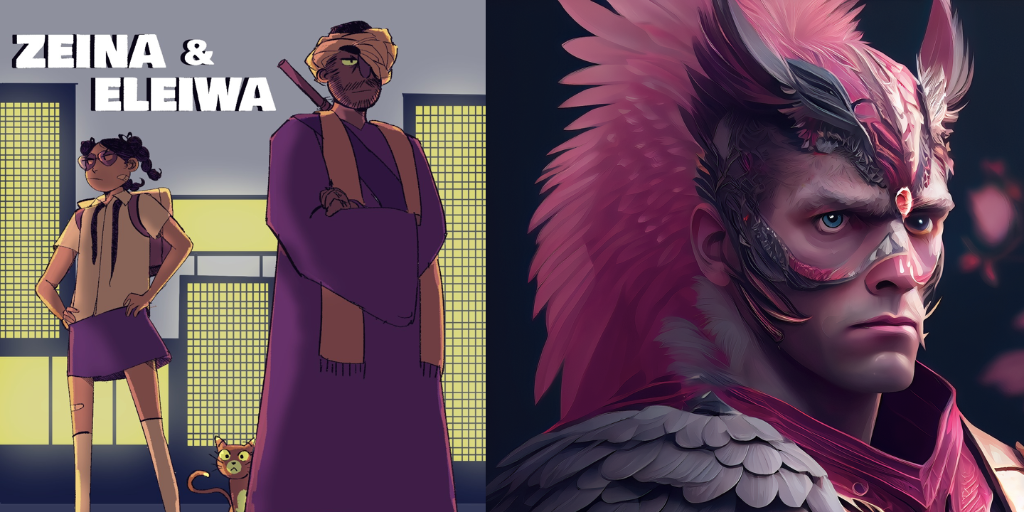Do perspectives on artificial intelligence (AI) generated art boil down to a difference of personal opinion, or is there something to be said for its impact on traditional versus digital artists? A conversation with both may provide insight on the matter.
AI art generators are software used to instantly create art based on written prompts. While it has helpful applications, like when it is used to complement art or streamline some animation processes, the current controversy centers around how the art AI has been trained on copyrighted material, and whether it will replace human-made art.
Artists claim the software is being used to take the pieces they spent hours making, only to churn it back out in seconds with the proper prompt. Some generators even have the option to enter prompts with specific artists’ names, so their style is copied in the product.
These softwares can create realistic-looking images, as long as viewers skip over details such as hands, which usually get botched. Nevertheless, AI art generators are constantly improving and are becoming more and more proficient at producing instant art from prompts.
“The big fuss right now isn’t ‘how can we use AI to help artists?’” Nour Tarabieh explains. “It’s ‘how can we use AI to get rid of artists?’”
Tarabieh is a senior in graphic design at the American University in Cairo (AUC) as well as the digital artist behind @nourtarts on Twitter, an art account with over 2,000 followers.
She believes AI generators could be exploitative of digital artists, such as how Mid-Journey has been accused of scraping artists’ works from the web with neither their consent nor compensation. Accordingly, she maintains that generators have the potential for misuse and mass art theft on digital platforms.
Batool Nader, on the other hand, is an artist with a different opinion: “If AI wasn’t going to [mimic people’s art], then other people would do it anyway.”
Nader is also a senior at AUC, a traditional artist in the visual arts department. For various reasons, she views AI art generators from a different lens compared to Tarabieh.
Breaking the matter down could shed light on the different factors influencing the local artists’ opinions.
The Creative Process
While Tarabieh acknowledges that some forms of AI art — like those used in ‘Spider-Man: Across the Spider-Verse’ — are harmless or even helpful to artists, there are also exploitative AI art generators that actively undermine creativity.
“It’s depressing to see the way people are discounting the creative process and the human element to art,” Tarabieh states.
She describes the art made from generators as “bleak” and “lifeless,” even if their appeal is in their realism and ease of creation.
Nader, on her part, adds, “[Artists] spend hours on one image, but these things make a million in one second.”
That being said, Nader does not agree with Tarabieh’s assessment. Rather than a killer of creativity, she sees the generators as more of a new medium.
“It’s kind of a trend for [Egyptian artists] to be obsessed with anything virtual,” she muses.
Additionally, Nader doubts the validity of claims of art theft in how AI repurposes art: “Artists have been doing that for years — it’s not new. People take an image that someone else created and just change it […] They’ve recreated the hell out of [famous pieces] over the years.”
Prevalence Among Egyptian Artists
While AI art has sparked a heated debate complete with mass online protests and lawsuits in the West, it has made less of a controversial impact in Egypt. Unless artists are actively exposed to the international controversy, AI generated art is more of a social media novelty.
“I find it on TikTok a lot,” Tarabieh notes. “It’s all over my FYP — I’m always seeing ‘characters of XYZ as Studio Ghibli characters!’ Yeah, it looks cute, but it’s also really bleak.”
Off of social media, however, Nader says that the interest in new art-related technologies is still growing among traditional Egyptian artists — though it may not necessarily be in the direction of AI.
For example, she recalls how all of the galleries she has recently attended in Egypt have featured at least one piece centered around virtual reality.
Tarabieh agrees that AI has not entered the public awareness in Egypt the same way it has abroad, and she believes this is for the better.
“All anyone wants to do is make the next DMC TV show, […] the next consumable thing,” she explains. “The only reason [AI] hasn’t affected Egypt so much as the US, in my opinion, is because Egypt is just a few steps behind.”
She worries that AI could be used by the Egyptian entertainment industry to “cut corners” just for the sake of creating new consumable content to profit off of, regardless of who is impacted. As such, Tarabieh also has concerns about the copyrights the generators would violate and whether or not it would be wise to attempt to try and regulate them.
In contrast, Nader is mostly indifferent to the emerging softwares in its entirety: “I’m not necessarily supporting it; it’s just fine with me. If anything, I think it’s just interesting.”
Different Perceptions
When asked about how she thought graphic designers should react to AI art generators, Nader’s comment was that they “definitely have to be scared.” She went on to share a story about an acquaintance who doubted the stability of their career path if corporations would so willingly trade their skills for quick, pretty AI images.
Understandably, such corporate decisions upset Tarabieh, who firmly maintains that “Art is way more than just something that looks good.”
Her issue with the generators lies in their exploitative nature. She laments the misuse of AI, since it has been used to help artists before, but is now being treated like a tool to replace them.
From the standpoints of both ethics and human creativity, Tarabieh does not support AI generators and the “bleak” art that they produce.
Nader, on the other hand, approaches the generators casually. In her view, art has overcome much more daunting obstacles over the course of history.
“I know a lot of people who see it as a threat to traditional art,” she concedes, “but I don’t think it is. It’s kind of like when the camera was invented. Before the camera, there was academic art […] it was perfect, almost like a picture. But then people started taking pictures, so it was like ‘why are we painting realistically?’”
Nader explains that this dilemma inspired artistic movements and forced artists to try new things. Essentially, she believes that if art survived the invention of the camera, it can survive anything. However, even if the situation is not exactly comparable, she remains confident that human-made art will prevail when the dust settles.
“At the end of the day, [AI art] is still 2D,” she says, reflecting on the bigger picture when it comes to art. “It can never give that experience of real life.”
With AI art more heavily involved in 2D image generation, her assessment holds — but it may only be a matter of time until AI finds itself used in 3D projects and designs or in other offline endeavors.
Subscribe to the Egyptian Streets’ weekly newsletter! Catch up on the latest news, arts & culture headlines, exclusive features and more stories that matter, delivered straight to your inbox by clicking here.






Comments (4)
[…] survive in a highly competitive and already constrained environment. market. Now they also have to compete with infinitely self-taught technology and mostly mediocre pseudo-artists with internet […]
[…] post Traditional vs Digital: The Impacts of AI Art Generators on Egyptian Artists first appeared on Egyptian […]